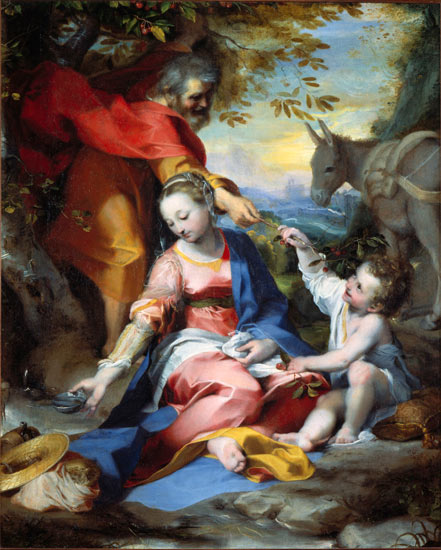The problem with looking at a photograph of a painting and, even more so, a backlit online image of a painting is that the aesthetics and way we read the paintings are fundamentally changed. This may seem an obvious statement, but it’s only when you try and recall certain nuances of an experience had with a painting that this idea really comes into effect.

Rest on the Flight from Egypt, 1570-3
Federico Barocci’s ‘Madonna of the Cat’ and 'Rest on the Flight from Egypt’ have a highly photographic feel about them. The soft lighting and interesting spatial play between characters makes them highly beautiful and complex paintings. Looking at them at the National Gallery’s current eponymous exhibition, it felt as if I were looking through a sort of photographic web, whereby objects would fall in and out of focus without real spatial structure. Whereas the lighting and form of the early Baroque artist’s faces would remain constant and blurred, other objects, such as a bird in the former, appear more rigid, and somehow slightly out of place.
Online, the compositions becomes more total, and spatial depth becomes somehow more formulaic and perhaps, ironically, more real. I want to get lost in the paintwork, the obscure proportions and depths that make me admire the artist’s work and feel inspired. Unfortunately, this is lost when seen out of context.
But the exhibition proved insightful and surprising. Barocci of Urbino was clearly an admirer of predecessors Da Vinci, Perugino, Raphael and the Venetians Giorgione and Veronese, each of whose depictions of gentle figures, naturalism, radiant light and grounded compositions are evident also in his early works. But perhaps also of Caravaggio, his contemporary, whose emphasis on strong contrasting levels of light, chiaroscuro, is very much apparent in Barocci’s later works.
I would note, however, that as the artist aged, and the commissions became grander and more complex, Barocci struggles to convince that he is up there with the great Renaissance masters of composition in Leonardo and Raphael. Figures sometimes appear unnecessary or out of place, and the scenery becomes a little too formulaic, exceptions of this being his great 'Last Supper’ and smaller 'Saint Francis’.
Barocci excels instead in his wealth of preparatory sketches and smaller paintings. Much like Rembrandt a few decades later, the Italian preferred to capture the more intimate and delicate moments, giving them a sense of life and empathy perhaps lost in the larger commissions. Sketches of hands and feet are done with a highly gentle slide of the pencil and brush and dab of the thumb, and the paintings are seemingly looser and more expressive.